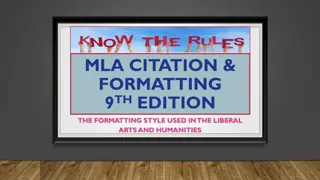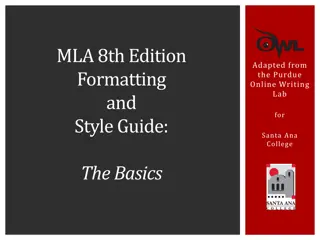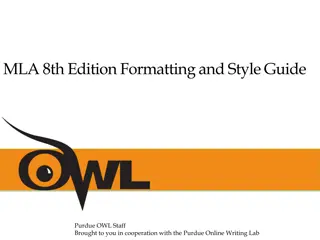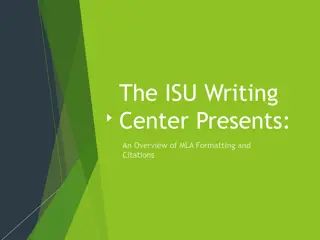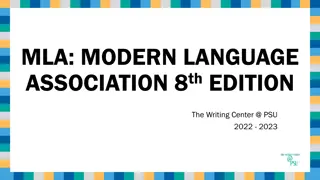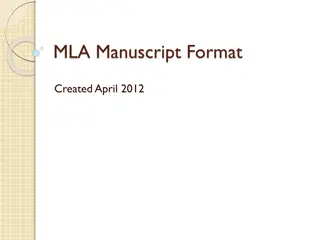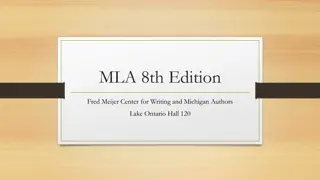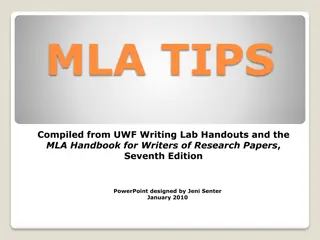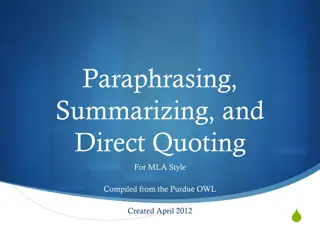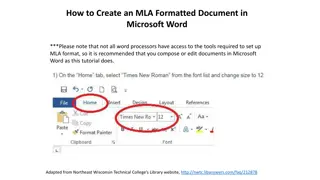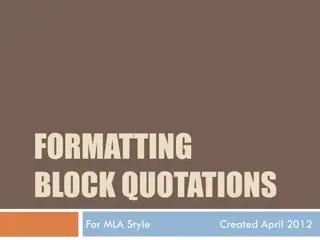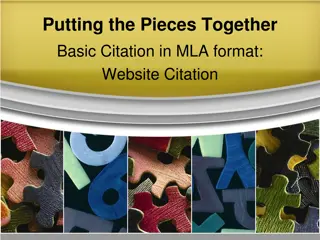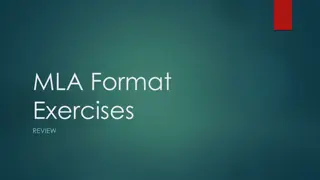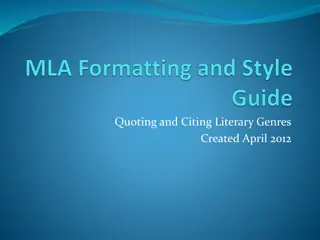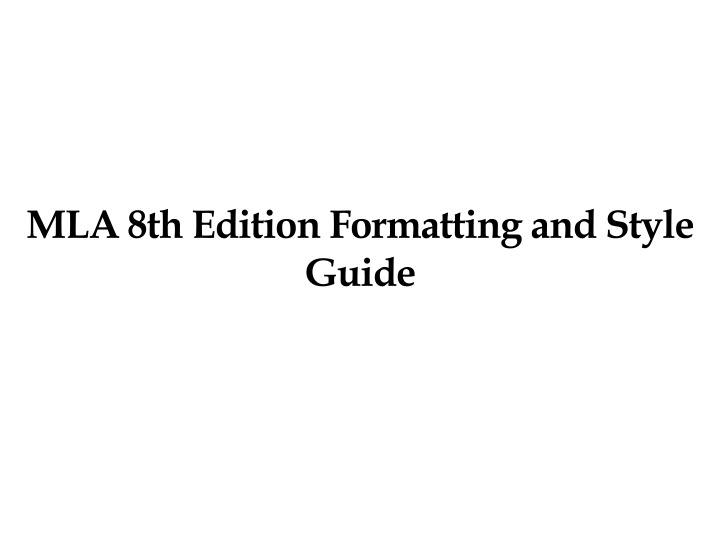
MLA 8th Edition Formatting Guide for Academic Papers
Learn how to format academic papers using MLA 8th Edition style guidelines, including document layout, in-text citations, works cited lists, and more. Following these standards ensures proper documentation of sources and prevents plagiarism.
Download Presentation

Please find below an Image/Link to download the presentation.
The content on the website is provided AS IS for your information and personal use only. It may not be sold, licensed, or shared on other websites without obtaining consent from the author. If you encounter any issues during the download, it is possible that the publisher has removed the file from their server.
You are allowed to download the files provided on this website for personal or commercial use, subject to the condition that they are used lawfully. All files are the property of their respective owners.
The content on the website is provided AS IS for your information and personal use only. It may not be sold, licensed, or shared on other websites without obtaining consent from the author.
E N D
Presentation Transcript
MLA (Modern Language Association) MLA Style formatting is used in humanities disciplines. The style of documentation outlined in the 8th edition serves the needs of students who are writing research papers, as well as scholars who publish professionally. MLA format provides writers with a uniform format for document layout and documenting sources. Proper MLA style shows that writers are conscientious of the standards of writing in their respective disciplines. Properly documenting sources also ensures that an author is not plagiarizing.
In addition to the handbook, MLA also offers The MLA Style Center, a website that provides additional instruction and resources for writing and formatting academic papers. https://style.mla.org/
MLA regulates: document format in-text citations works-cited list
This presentation will cover: How to format a paper in MLA style (8th ed.) General guidelines First page format Section headings In-text citations Formatting quotations Documenting sources in MLA style (8th ed.) Core elements List of works cited
Basic rule for any formatting style: Always Follow your instructor s guidelines Many instructors who require their students to use MLA formatting and citation style have small exceptions to different MLA rules. Every bit of instruction and direction given in this presentation comes with this recommendation: ALWAYS follow the specific instructions given by your instructor.
Format: General Guidelines Double-space everything (including heading, block quotations, footnotes/endnotes, list of works cited) Use 12 pt. Times New Roman font Leave only one space after punctuation Set all margins to 1 inch (2.54 cm) on all sides Indent the first line of paragraphs one half-inch (1,27 cm)
Format: General Guidelines An MLA Style paper should: Have a header with page numbers located in the upper right-hand corner Use italics for titles Place endnotes on a separate page before the list of works cited. (Title the section Notes.)
Formatting the 1st Page Have no title page (unless it is requested) Double space everything List your name, your instructor's name, the course, and date in the upper left-hand corner Center the paper title (use standard caps but no underlining, italics, quote marks, or bold typeface) (not in all capital letters) Create a header in the upper right corner at half inch from the top and one inch from the right of the page (list your last name and page number here) Note: Your instructor may ask that you omit last name/page number header on your first page. Always follow instructor guidelines.)
Formatting Section Headings Writers sometimes use Section Headings to improve a document s readability. These sections may include individual chapters or other named parts of a book or essay. Section Headings are generally optional: Headings in an essay should usually be numbered Headings should be consistent in grammar and formatting
Sample Section Headings Numbered (all flush left with no underlining, bold, or italics): Example: 1. Soil Conservation 1.1 Erosion 2. Water Conservation 3. Energy Conservation
In-Text Citations: Basic Rules An in-text citation is a brief reference in your text that indicates the source you consulted. It should direct readers to the entry in your works-cited list for that source. a natural pause to your text: provide the citation information without interrupting your own text. In general, the in-text citation will be the author s last name (or abbreviated title) with a page number, enclosed in parentheses.
In-Text Citations: Basic Rules Quote when you can't say it any better than the author did, but paraphrase when you can.
Author-Page Style MLA format follows the author-page method of in- text citation. This means that the author's last name and the page number(s) from which the quotation or paraphrase is taken must appear in the text, and a complete reference should appear in your works-cited page. The author's name may appear either in the sentence itself or in parentheses following the quotation or paraphrase, but the page number(s) should always appear in the parentheses, not in the text of your sentence.
Author-Page Style Wordsworth, William. Lyrical Ballads. Oxford UP, 1967.
Print Source with Author For the following print source Burke, Kenneth. Language as Symbolic Action: Essays on Life, Literature, and Method. U of California P, 1966. If the essay provides a signal word or phrase usually the author s last name the citation does not need to also include that information.
Citing Works With Multiple Editions In parenthetical citations of a literary work available in multiple editions, such as a commonly studied novel, it is often helpful to provide division numbers in addition to page numbers so that your readers can find your references in any edition of the work. In-text example: Marx and Engels described human history as marked by class struggles (79; ch. 1).
Citing Authors with Same Last Names Make sure that your in-text citations refer unambiguously to the entry in your works-cited list. If you are citing from the works of two different authors with the same last name, include the author s first initial in your reference). In-text example: Although some medical ethicists claim that cloning will lead to designer children (R. Miller 12), others note that the advantages for medical research outweigh this consideration (A. Miller 46).
Citing Works by Multiple Authors Two authors: If the entry in the works-cited list begins with the names of two authors, include both last names in the in-text citation, connected by and. A 2016 study suggests that stricter gun control in the United States will significantly prevent accidental shootings (Strong and Ellis 23). Three or more authors: If the source has three or more authors, the entry in the works-cited list should begin with the first author s name followed by et al. The in-text citation should follow suit. Smith et al. argues that tougher gun control is not needed in the United States (76). The authors state: Tighter gun control in the United States erodes Second Amendment rights (Smith et al. 76).
Citing Multiple Works by the Same Author If you cite more than one work by a particular author, include a shortened title for the particular work from which you are quoting to distinguish it from the others. Lightenor has argued that computers are not useful tools for small children ( Too Soon 38), though he has acknowledged elsewhere that early exposure to computer games does lead to better small motor skill development in a child's second and third year ( Hand-Eye Development 17).
Citing Multiple Works by the Same Author 2 If the author's name is not mentioned in the sentence, format your citation with the author's name followed by a comma, followed by a shortened title of the work, followed, when appropriate, by page numbers. This is illustrated in the second example on this slide. Visual studies, because it is such a new discipline, may be too easy (Elkins, Visual Studies 63).
Citing Indirect Sources Sometimes you may have to use an indirect source. An indirect source is a source cited in another source. For such indirect quotations, use qtd. in to indicate the source you actually consulted. This is illustrated in the first example on this slide. Note that, in most cases, a responsible researcher will attempt to find the original source, rather than citing an indirect source. In-text example: Ravitch argues that high schools are pressured to act as social service centers, and they don't do that well (qtd. in Weisman 259).
Citing Multiple Citations If you borrow more than once from the same source within a single paragraph and no other source intervenes, you may give a single parenthetical reference after the last borrowing. : Romeo and Juliet presents an opposition between two worlds: the world of the everyday and the world of romance. Although the two lovers are part of the world of romance, their language of love nevertheless becomes fully responsive to the tang of actuality (Zender 138, 141).
Formatting Short Quotations (in Prose) If a prose quotation runs no more than four lines and requires no special emphasis, put it in quotation marks and incorporate it into the text.. Provide the author and specific page citation in the text, and include a complete entry in the works-cited page. Punctuation marks such as periods, commas, and semicolons should appear after the parenthetical citation. Question marks and exclamation points should appear within the quotation marks if they are a part of the quoted passage but after the parenthetical citation if they are a part of your text.
Formatting Short Quotations (in Prose) Short prose quotations In-text example: According to some, dreams express profound aspects of personality (Foulkes 184), though others disagree. According to Foulkes's study, dreams may express profound aspects of personality (184). Is it possible that dreams may express profound aspects of personality (Foulkes 184)?
Formatting Long Quotations (Prose) In quotations that are five or more lines of text, start the quotation on a new line, with the entire quote indented half an inch from the left margin; maintain double-spacing. Do not indent the first line an extra amount or add quotation marks not present in the original. Use a colon to introduce the quotation (unless your introductory wording does not require punctuation). Your parenthetical citation should come after the closing punctuation mark. Note: If a new paragraph begins in the middle of the quotation, indent its first line.
Formatting Long Quotations (Prose) Quoting more than four lines of prose In-text example: Nelly Dean treats Heathcliff poorly and dehumanizes him throughout her narration: They entirely refused to have it in bed with them, or even in their room, and I had no more sense, so, I put it on the landing of the stairs, hoping it would be gone on the morrow. By chance, or else attracted by hearing his voice, it crept to Mr. Earnshaw's door, and there he found it on quitting his chamber. Inquiries were made as to how it got there; I was obliged to confess, and in recompense for my cowardice and inhumanity was sent out of the house. (Bronte 78)
Formatting Short Quotations in Poetry Quoting 1-3 lines of poetry Examples: Properzia Rossi tells the statue that it will be a container for her feelings: The bright work grows / Beneath my hand, unfolding, as a rose (lines 31- 32). In The Thorn, Wordsworth s narrator locates feelings of horror in the landscape: The little babe was buried there, / Beneath that hill of moss so fair. // I ve heard the scarlet moss is red (stanzas xx-xxi).
Formatting Long Quotations in Poetry Use block quotations for three or more lines of poetry. If the poem is formatted in an unusual way, reproduce the unique formatting as accurately as possible.
Quotations: Drama Italicize the titles of plays. Richard III or Othello Place a parenthetical reference after each quotation containing its act, scene, and line numbers separated by periods. Do not use page numbers. Cite line-number ranges under 100 like this: 34 37. Above 100, repeat only the last two digits of the second number: 211 12 (but of course, 397 405 and 96 102). Twelfth Night (1.5.268 76)
Quotations: Drama Use arabic numerals for all reference numbers. (Some older texts used roman numerals for act and scene references like this: III.viii.7 34 but modern scholars use arabic numerals.) You may refer to a scene in the text with the act and scene numbers in arabic numerals separated by a period. In 3.1, Hamlet delivers his most famous soliloquy. Do not say: In Act III,scene i, Hamlet delivers his most famous soliloquy.
Quotations: Drama Periods and commas always go inside quotation marks. Periods and commas, says Dr. Womack, always go inside quotation marks.
Quotations: Drama (Verse Quotations) If you quote all or part of a single line of verse, put it in quotation marks within your text. Berowne s pyrotechnic line Light, seeking light, doth light of light beguile is a text-book example of antanaclasis (1.1.77). Incorporate two or three lines in the same way, using a slash with a space on each side [ / ] to separate them. Claudius alludes to the story of Cain and Abel when describing his crime: It hath the primal eldest curse upon t, / A brother s murder (3.3.37 38).
Quotations: Drama (Verse Quotations) Set verse quotations of more than three lines as block quotations. Start a new line and set each line one inch in from the left margin, adding no quotation marks not appearing in the original. If the quotation starts in the middle of a line of verse, reproduce it that way, don t shift it to the left margin In the parenthetical reference at the end of the quote, include the act, scene, and line(s) of your quote, instead of the page number(s):
Quotations: Drama (Dialogue Quotations) If you quote dialogue between characters in a play, set it as a block quotation as described above. Begin each part of the dialogue with the appropriate character s name written in all capital letters. Place a period after the name; then start the quotation. Indent any subsequent lines of the character s speech an extra quarter inch. When the dialogue shifts to a new character, start a new line. Maintain this pattern throughout the quotation.
Quotations: Drama (Dialogue Quotations) SHYLOCK. She is damned for it. SALARINO. That s certain, if the devil may be her judge. SHYLOCK. My own flesh and blood to rebel! SOLANIO. Out upon it, old carrion! Rebels it at these years? SHYLOCK. I say my daughter is my flesh and my blood. SALARINO. There is more difference between thy flesh and hers than between jet and ivory, more between your bloods than there is between red wine and Rhenish. (3.1.29 38)
Adding/Omitting Words If you add a word or words in a quotation, you should put brackets around the words to indicate that they are not part of the original text. This is illustrated in the first example on this slide. If you omit a word or words from a quotation, you should indicate the deleted word or words by using ellipsis marks, which are three periods ( . . . ) preceded and followed by a space.
Works Cited: The Basics Each entry in the list of works cited is made up of core elements given in a specific order. The core elements should be listed in the order in which they appear here. Each element is followed by the punctuation mark shown here.
Works-cited List: Author Begin the entry with the author s last name, followed by a comma and the rest of the name, as presented in the work. End this element with a period. Examples: Baron, Naomi S. Redefining Reading: The Impact of Digital Communication Media. PMLA, vol. 128, no. 1, Jan. 2013, pp.193-200. Jacobs, Alan. The Pleasures of Reading in an Age of Distraction. Oxford UP, 2011.
Works-cited List: Title of Source Books and websites should be in italics: Linett, Maren Tova. Modernism, Feminism, and Jewishness. Cambridge UP, 2007. Periodicals (journal, magazine, newspaper article) should be in quotation marks: Goldman, Anne. Questions of Transport: Reading Primo Levi Reading Dante. The Georgia Review, vol. 64, no. 1, 2010, pp. 69- 88.
Works-cited List: Title of Container Containers are the larger wholes in which the source is located. For example, if you want to cite a poem that is listed in a collection of poems, the individual poem is the source, while the larger collection is the container. The title of the container is usually italicized and followed by a comma, since the information that follows next describes the container.
Works-cited List: Title of Container Examples: Bazin, Patrick. Toward Metareading. The Future of the Book, edited by Geoffrey Nunberg, U of California P, 1996, pp. 153-68. Hollmichel, Stefanie. The Reading Brain: Differences between Digital and Print. So Many Books, 25 Apr. 2013, somanybooksblog.com/2013/04/25/the-reading- brain-differences-between-digital-and-print/.
Works-cited List: Other Contributors In addition to the author, there may be other contributors to the source who should be credited, such as editors, illustrators, performers, translators, contributions are relevant to your research, or necessary to identify the source, include their names in your documentation. etc. If their Note: In the eighth edition, terms like editor, illustrator, translator, etc., are no longer abbreviated.
Works-cited List: Other Contributors Examples: Chartier, Roger. The Order of Books: Readers, Authors, and Libraries in Europe between the Fourteenth and Eighteenth Centuries. Translated by Lydia G. Cochrane, Stanford UP, 1994. Woolf, Virginia. Jacob s Room. Annotated and with an introduction by Vara Neverow, Harcourt, Inc., 2008.
Works-cited List: Version Books are commonly issued in versions called editions. A revised edition of a book may be labeled revised edition, or be numbered (second edition, etc.). If a source is listed as an edition or version of a work, include it in your citation. The Bible. Authorized King James Version, Oxford UP, 1998. Newcomb, Horace, editor. Television: The Critical View. 7th ed., Oxford UP, 2007.
Works-cited List: Number If a source is part of a numbered sequence, such as a multi- volume book, or journal with both volume and issue numbers, those numbers must be listed in your citation. Baron, Naomi S. Redefining Reading: The Impact of Digital Communication Media. PMLA, vol. 128, no. 1, Jan. 2013, pp. 193-200. Wellek, Ren . A History of Modern Criticism, 1750-1950. Vol. 5, Yale UP, 1986.
Works-cited List: Publisher The publisher produces or distributes the source to the public. If there is more than one publisher, and they are all are relevant to your research, list them in your citation, separated by a forward slash (/). Example: Jacobs, Alan. The Pleasures of Reading in an Age of Distraction. Oxford UP, 2011.
Works-cited List: Publication Date The same source may have been published on more than one date, such as an online version of an original source. When the source has more than one date, use the date that is most relevant to your use of it. (If you re unsure about which date to use, go with the date of the source s original publication.) Belton, John. Painting by the Numbers: The Digital Intermediate. Film Quarterly, vol. 61, no. 3, Spring 2008, pp. 58-65.


